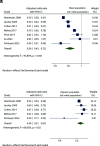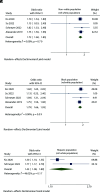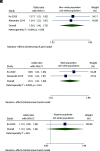Racial Disparities in Minimally Invasive Benign Hysterectomy
- PMID: 39749229
- PMCID: PMC11694781
- DOI: 10.4293/JSLS.2024.00018
Racial Disparities in Minimally Invasive Benign Hysterectomy
Abstract
Background and objectives: Racial and ethnic disparities in access to minimally invasive surgery (MIS) and the rate of surgical complications in minority groups remain profoundly underinvestigated. This meta-analysis aims to compare the rate of MIS utilization for benign hysterectomy as well as the surgical morbidity among racial and ethnic minority patients in the United States.
Methods: Studies comparing utilization rate of MIS for benign hysterectomy among non-Hispanic white, Black, and Hispanic populations were considered eligible. The primary outcome was the rate of MIS according to race. The secondary outcome was surgical morbidity risk (Clavien-Dindo Classification) according to hysterectomy route and race. Random-effect model meta-analysis pooled unadjusted and adjusted odds ratios (ORs) with 95% confidence intervals (CIs).
Results: Thirteen studies were eligible, with a total of 1,123,851 patients undergoing benign hysterectomy, of whom 817,209 were white, 187,488 Black, and 119,154 Hispanic. Black and Hispanic patients were less likely to undergo MIS compared to white patients (Black: OR 0.44 [95% CI 0.39-0.49] and Hispanic: OR 0.65 [95% CI 0.59-0.71]). After pooling adjusted estimates, the rate of MIS use remained significantly lower in nonwhite populations. Nonwhite patients were more likely to develop surgical complications after hysterectomy in either MIS (OR 1.32 [95% CI: 1.15-1.52]) or open hysterectomy (OR 1.56 [95% CI: 1.40-1.73]).
Conclusion: Racial and ethnic disparities in MIS utilization for benign hysterectomy are strikingly apparent in the United States, with nonwhite patients often demonstrating lower access to MIS utilization and higher rates of surgical morbidity than white patients.
Keywords: Disparity; Ethnicity; Hysterectomy; Minimally invasive; Race.
© 2024 by SLS, Society of Laparoscopic & Robotic Surgeons.
Conflict of interest statement
Conflict of interests: none.
Figures






Similar articles
-
Racial/Ethnic Disparities/Differences in Hysterectomy Route in Women Likely Eligible for Minimally Invasive Surgery.J Minim Invasive Gynecol. 2020 Jul-Aug;27(5):1167-1177.e2. doi: 10.1016/j.jmig.2019.09.003. Epub 2019 Sep 10. J Minim Invasive Gynecol. 2020. PMID: 31518712 Free PMC article.
-
Associations between race and ethnicity and perioperative outcomes among women undergoing hysterectomy for adenomyosis.Fertil Steril. 2024 Jun;121(6):1053-1062. doi: 10.1016/j.fertnstert.2024.02.003. Epub 2024 Feb 10. Fertil Steril. 2024. PMID: 38342374
-
Social determinants of access to minimally invasive hysterectomy: reevaluating the relationship between race and route of hysterectomy for benign disease.Am J Obstet Gynecol. 2017 Nov;217(5):572.e1-572.e10. doi: 10.1016/j.ajog.2017.07.036. Epub 2017 Aug 4. Am J Obstet Gynecol. 2017. PMID: 28784416
-
Racial and ethnic disparities in access to minimally invasive gynecologic surgery for benign pathology.Curr Opin Obstet Gynecol. 2021 Aug 1;33(4):279-287. doi: 10.1097/GCO.0000000000000719. Curr Opin Obstet Gynecol. 2021. PMID: 34016820 Review.
-
Health Care Disparities in Patients Undergoing Hysterectomy for Benign Indications: A Systematic Review.Obstet Gynecol. 2023 Nov 1;142(5):1044-1054. doi: 10.1097/AOG.0000000000005389. Obstet Gynecol. 2023. PMID: 37826848
Cited by
-
The relation of heavy or prolonged bleeding during the menopause transition to risk of hysterectomy.Womens Health (Lond). 2025 Jan-Dec;21:17455057251351418. doi: 10.1177/17455057251351418. Epub 2025 Jul 10. Womens Health (Lond). 2025. PMID: 40637738 Free PMC article.
References
-
- Ko JS, Suh CH, Huang H, Zhuo H, Harmanli O, Zhang Y. Association of race/ethnicity with surgical route and perioperative outcomes of hysterectomy for leiomyomas. J Minim Invasive Gynecol. 2021;28(7):1403–1410.e2. - PubMed
-
- Practice CoG. Choosing the route of hysterectomy for benign disease. Obstetrics and Gynecology. 2017;129(6):E155–E159. - PubMed
Publication types
MeSH terms
LinkOut - more resources
Full Text Sources
Medical
